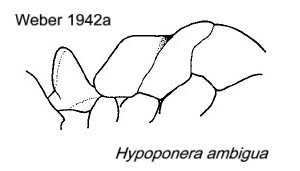Fisheropone ambigua (Weber)
  Type location South Sudan
(Ponera
ambigua, Weber, 1942a: 46, illustrated, worker; new genus Fisheropone with this as type species defined by Schmidt & Shattuck, 2014: 87) from Mount Imatong,
collected by the author, worker only (see Bolton, 1995) Type location South Sudan
(Ponera
ambigua, Weber, 1942a: 46, illustrated, worker; new genus Fisheropone with this as type species defined by Schmidt & Shattuck, 2014: 87) from Mount Imatong,
collected by the author, worker only (see Bolton, 1995)  . .
Genus separation: Clypeus narrowly inserted
between frontal lobes, the antennal sockets closely approximated;
metatibiae with single pectinate spur; tarsal claws unarmed;
mandibles not elongated, inserted at or near the anterolateral corners
of the head; eyes not set on prominent ocular prominences; (mesotibiae
dorsally without abundant stout traction setae (a few stout setae
sometimes present near tarsus but never extending along length of
tibia; eyes absent (or present only as a pigmented spot);
metanotal groove angular, the propodeum depressed below the mesonotum.
Schmidt and Shattuck gave: "Diagnosis. Fisheropone
workers can be diagnosed by the following unique combination of
characters: mandibles narrowly triangular, relatively long and without
a basal pit or fovea; clypeus narrowly inserted between small frontal
lobes, the antennal sockets closely approximated; propodeal spiracle
slit-shaped; mesotibiae dorsally without abundant stout traction setae
and ventral apex of the metatibia with a single pectinate spur; and
petiole scale-like and thin. These ants bear a superficial resemblance
to Hypoponera and Mesoponera in being relatively slender and with elongate mandibles and an impressed metanotal groove. They can be separated from Hypoponera by the slit-shaped rather than round propodeal spiracle, and from Mesoponera by the presence of only a single metatibial spur. Separation from the single African species of Cryptopone is based on the lack of a basal mandibular pit and mesotibial pusher setae, both of which are present in Cryptopone."
Although they gave the distribution of the two genus members, F. ambigua
and an unnamed form, as "Cameroon, Gabon, South Sudan, Tanzania,
Uganda" they gave no supporting information, other than the Uganda
worker shown below, and do not appear to have sighted the Weber type
specimen. Their description of F. ambigua in itself falls below normal standards.
|
 Weber's
(1942a) description is at Weber's
(1942a) description is at  . .
WORKER (after Bernard, 1952) - TL 2.5 mm, yellow-brown,
scape length surpassing the posterior border of the head, eyes minimal
and placed at about the centre of the cheeks.
My note from 2007, unreferenced by Schmidt & Shattuck, was "Clearly it differs from Pachycondyla
(Mesoponera) ambigua (lower), therefore, I have included it
here [in Hypoponera], but point out that its status as a Hypoponera is
unresolved".
Bolton (1995) did not list it under Hypoponera
but under Pachycondyla as an "unresolved junior secondary
homonym of Pachcondyla ambigua" adding "Combination in Pachycondyla:
Brown, new combination".
Presumably, from its inclusion in his key, Bernard was
satisfied its distribution included West Africa.
|